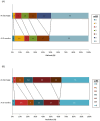Prognostic factors in aneurysmal subarachnoid hemorrhage with poor initial clinical grade
- PMID: 40242616
- PMCID: PMC12000015
- DOI: 10.3389/fneur.2025.1536643
Prognostic factors in aneurysmal subarachnoid hemorrhage with poor initial clinical grade
Abstract
Introduction: Aneurysmal subarachnoid hemorrhage (aSAH) is a rare cause of stroke that poses significant morbidity and mortality, as it affects patients around the age of 50 years. While advances in early aneurysm intervention have reduced mortality rates, many patients still experience poor outcomes due to early brain injury (EBI) and delayed cerebral ischemia (DCI). This study aims to explore the characteristics of patients with poor neurological outcomes among patients with poor neurological status at admission, using comprehensive clinical and neuroimaging data.
Methods: We analyzed 377 aSAH patients (WFNS 4-5) admitted between 2013 and 2020, focusing on demographics, clinical assessments, imaging, treatments, and outcomes at discharge and 3 months later.
Results: Among the cohort, which predominantly consisted of females, the mortality rate was 49%. Our findings indicate that older patients had poorer functional outcomes; notably, 59% of patients aged 75 and older had limitations on therapeutic efforts, leading to a 100% mortality rate in that subgroup. There was no difference in outcomes between endovascular and surgical treatments. However, patients undergoing multimodal monitoring had better functional outcomes at discharge. Angiographic vasospasm was found in 31% of patients and was linked to poorer outcomes at discharge (p = 0.016). Though DCI did not directly correlate with functional outcomes, it correlated strongly with new cerebral infarcts (90% incidence).
Conclusion: The prognosis of patients with aSAH and poor neurological status on admission is generally poor. Multimodal monitoring and tailored treatment appear to be beneficial in achieving favorable results in these patients. Despite the initial severity, up to 20% of patients achieve a good functional result on discharge and up to 35% do so at 3 months. These should be considered in the initial prognostic assessment with the families of these patients.
Keywords: DCI; SAH; WFNS; aneurysm; functional outcome; multimodal monitoring.
Copyright © 2025 Culebras, Pedrosa, Mosteiro, Llull, Topczewski, Zattera, Díez-Salvatierra, Dolz, Amaro and Torné.
Conflict of interest statement
The authors declare that the research was conducted in the absence of any commercial or financial relationships that could be construed as a potential conflict of interest.
Figures



Similar articles
-
Thick and diffuse cisternal clot independently predicts vasospasm-related morbidity and poor outcome after aneurysmal subarachnoid hemorrhage.J Neurosurg. 2020 May 22;134(5):1553-1561. doi: 10.3171/2020.3.JNS193400. Print 2021 May 1. J Neurosurg. 2020. PMID: 32442971
-
Clinical Burden of Angiographic Vasospasm and Its Complications After Aneurysmal Subarachnoid Hemorrhage: A Systematic Review.Neurol Ther. 2023 Apr;12(2):371-390. doi: 10.1007/s40120-022-00436-7. Epub 2023 Jan 7. Neurol Ther. 2023. PMID: 36609962 Free PMC article. Review.
-
Economic and Humanistic Burden of Cerebral Vasospasm and Its Related Complications after Aneurysmal Subarachnoid Hemorrhage: A Systematic Literature Review.Neurol Ther. 2022 Jun;11(2):597-620. doi: 10.1007/s40120-022-00348-6. Epub 2022 Apr 20. Neurol Ther. 2022. PMID: 35441974 Free PMC article. Review.
-
Serum Alkaline Phosphatase Level is Associated with Angiographic Vasospasm, Delayed Cerebral Ischemia-Caused Clinical Deterioration, and Functional Outcome After Aneurysmal Subarachnoid Hemorrhage.Neurocrit Care. 2019 Dec;31(3):466-475. doi: 10.1007/s12028-019-00714-7. Neurocrit Care. 2019. PMID: 31016639
-
Spinal Drainage and Combined Pharmacotherapy as Potential Strategies to Improve Outcomes for Patients with Poor-Grade Subarachnoid Hemorrhage Treated with Clipping or Coiling but Not Receiving Nimodipine.J Clin Med. 2025 Apr 15;14(8):2715. doi: 10.3390/jcm14082715. J Clin Med. 2025. PMID: 40283546 Free PMC article.
References
LinkOut - more resources
Full Text Sources

